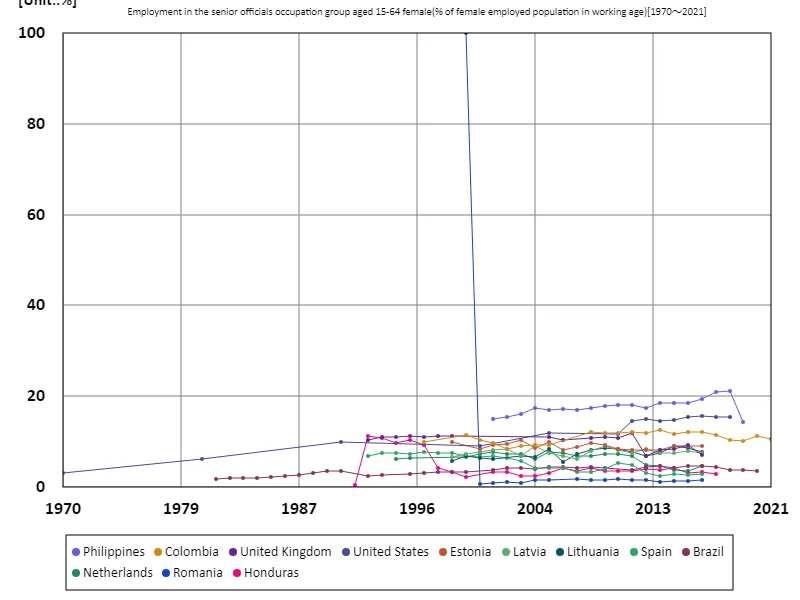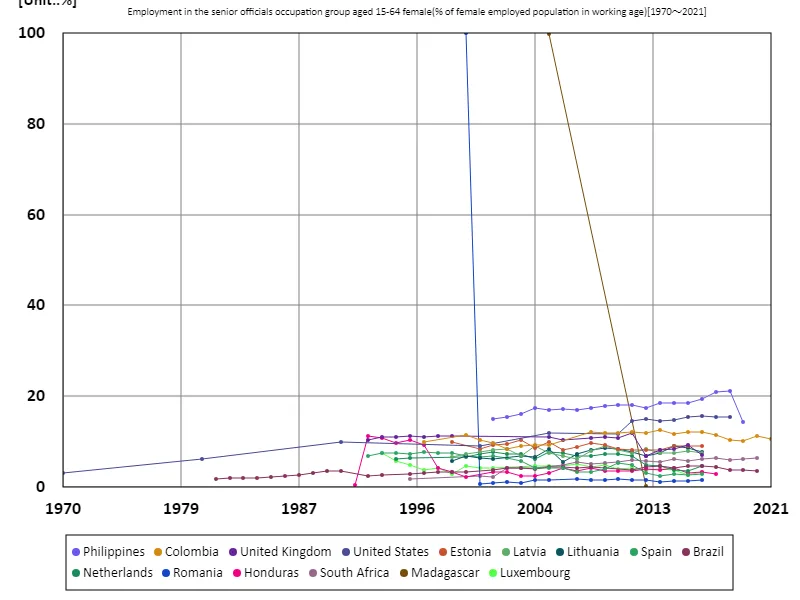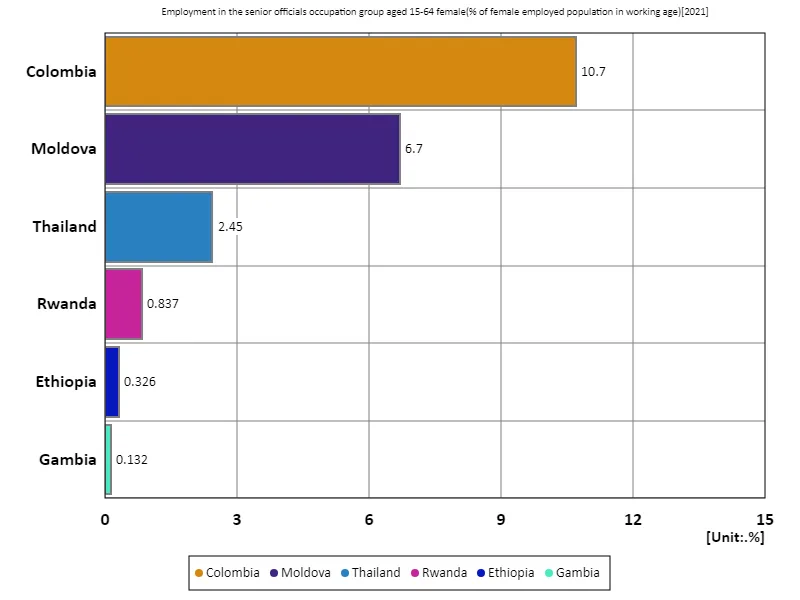- Abstract
- Employment rate for women aged 15-64 in senior civil service positions (percentage of working-age female employment population)
- Employment rate of women aged 15-64 in senior civil service positions (percentage of working-age female employment population) (Worldwide)
- Employment rate of women aged 15-64 in senior civil service positions (percentage of working-age female employment population) (Worldwide, latest year)
- Reference
Abstract
There are large differences between countries when it comes to employment rates for women aged 15-64 in the senior civil service sector. According to 2021 data, Colombia has the highest employment rate at 10.7%. The figures suggest that women are making relatively good inroads into senior civil service positions in Colombia. In general, employment rates in the senior civil service sector are influenced by women’s educational levels and equality of professional opportunities. In recent years, Colombia has seen an expansion of educational opportunities and an increase in career opportunities for women, resulting in an increase in the proportion of women in senior civil servant positions. Meanwhile, in many other countries, the ratio of men to women in senior roles remains low. This is thought to be due to structural issues such as gender bias in the workplace and unequal opportunities for promotion. The data suggests that countries where women are increasingly entering senior civil service sectors may be making progress towards overall gender equality, while challenges remain in other countries.
Employment rate for women aged 15-64 in senior civil service positions (percentage of working-age female employment population)
The employment rate of women aged 15-64 in the senior civil service sector in data from 1970 to 2021 shows notable changes. The data from Romania in particular are interesting. In 1999, Romania recorded an astounding 100% female representation in the senior civil service, but today this figure has fallen to 1.57%. Romania’s high employment rate in the late 1990s was the result of socialist-era policies, which actively promoted women into civil service positions. During this period, Romania encouraged women to participate in the workforce, with a particularly high proportion in senior positions. However, since the 2000s, economic reforms and political upheavals have led to a sharp decline in the employment rate of women in senior civil servant positions. This trend reflects economic transitions, policy changes, or economic pressures that limit women’s entry into the civil service. Economic reforms and political instability, as seen in many countries, can have a negative impact on women’s high professional status. The example of Romania is particularly noteworthy as it illustrates the impact of institutional change on the labour market.


The maximum is 100%[1999] of Romania, and the current value is about 1.57%
Employment rate of women aged 15-64 in senior civil service positions (percentage of working-age female employment population) (Worldwide)
Data covering the period from 1970 to 2021 shows that the employment rate of women aged 15-64 in senior civil service positions has fluctuated significantly over time. The case of Romania is particularly striking. In 1999, Romania recorded an unusually high rate of 100%, but today it has fallen to just 1.57%. Romania’s high employment rate in 1999 was due to policies implemented during the socialist era. During this period, women’s participation in the profession was actively encouraged and the proportion of women in senior civil service positions was very high. However, the economic transition and political reforms since the 2000s have brought about major changes in the system, as well as changes in the economic structure and market liberalization, which have resulted in a significant decline in the employment rate of women in senior positions. This fluctuation illustrates the impact of economic change and political instability on career opportunities for women. In many countries, women’s high professional status is sometimes threatened, especially in the face of rapid economic and political change. The example of Romania provides an important case study in examining the impact of institutional change on women’s employment status.


The maximum is 100%[1999] of Romania, and the current value is about 1.57%
Employment rate of women aged 15-64 in senior civil service positions (percentage of working-age female employment population) (Worldwide, latest year)
In 2021 data, employment rates in senior civil service sector positions for women aged 15-64 vary widely across countries. Colombia has the highest rate at 10.7%, with an average of 3.53% and an overall total of 21.2%. This figure reflects international trends regarding the employment status of women in senior civil service roles. Colombia’s high employment rate reflects the relative progress of women in public service jobs. This is thought to be due to the expansion of educational opportunities for women and active policy promotion. Meanwhile, the average figure of 3.53% and the total figure of 21.2% indicate that the proportion of women in senior civil service positions remains low in many countries. This is likely due to institutional barriers, cultural factors, and unequal promotion opportunities. Overall, while progress in increasing women’s participation in senior civil service roles shows differing regions and countries, the overall figures highlight that closing the gender gap remains a key challenge going forward. It is expected that national policies and societal changes will contribute to further progress in this field.


The maximum is 10.7% of Colombia, the average is 3.53%, and the total is 21.2%



Comments